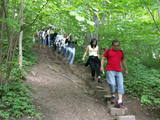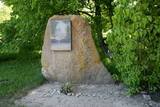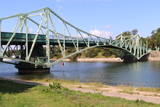| Nr | Name | Beschreibung |
|---|---|---|
|
Ein mit Wäldern bedecktes Gebiet, durch welches der Fluss Gauja fließt. Alte Flussärme, parkartige Eichenwiesen, Laubwälder und Schutzarte. Naturpfade. |
||
|
Es ist ein Ort, wo man kurze und lange Spaziergänge machen kann. Hier ist der 1,6 km lange Pfad von Sprīdītis (mit Holzskulpturen der Helden aus den Märchen der Schriftstellerin Anna Brigadere), der 3,8 km lange Waldlehrpfad und der 8 km (eine Richtung) lange Landschaftspfad von Augšzeme. Alle Pfade befinden sich in einer subglazialen Bettung, wo sich einer nach dem anderen kleine Seen und Sümpfe befinden, die mit Durchflüssen verbunden sind. Zum Schutz der Landschaft und anderer Werte ist hier ein Naturschutzgebiet eingerichtet worden. An der Stelle, wo die Pfade anfangen (unweit von Pilskalne), ist der ungefähr 30 Meter hohe Hügel Melnaiskalns (Schwarzberg oder der Burgberg von Rāmava) zu besichtigen. |
||
|
This 368 metre structure is the highest television tower in the European Union. Its viewing area, which is at a height of 97 metres, is the highest publicly available viewing area in Latvia. The location offers a fantastic view of Rīga and Old Rīga to Pārdaugava, the Bay of Rīga and Sigulda – a radius of at least 50 kilometres.
|
||
|
Das Restaurant befindet sich im achten Stockwerk der heiligen Dreieinigkeitskirche von Jelgava mit einer wunderbaren Aussicht auf die wichtigsten kulturhistorischen Denkmälern. Hier werden feine französische Küche popularisiert und Speisen für einfache und geschäftliche Mittagessen angeboten. Lettische Küche: Heringsfilet mit hausgemachtem Quark, Kartoffeln und Zwiebeln. Das besondere Gericht: Kuchen der Marie. |
||
|
Ein herforragender Sandsteinfelsen am rechten Ufer des Flusses Gauja mit Blick aufs Urstromtal von Gauja und einen Naturpfad. Erholungs- und Feuerplatz. |
||
|
Die Ruinen der um 1500 gebauten eindrucksvollen Kirche, die man besichtigen kann. Das Gebäude wurde nach dem Luftangriff 1942 beschädigt. |
||
|
Ursprünglich war der Gedenkstein für den lettischen Staatspräsidenten Gustavs Zemgals (1871-1939) im Jahre 1990 bei dessen Geburtshaus „Brātiņi“ errichtet worden, 2016 wurde er jedoch in den Gedenkpark in Džūkste versetzt. |
||
|
The craftsman manufactures barrels, hot tubs, furniture, stairs, doors and other useful objects. You can take a tour, learn about the relevant skills and experience, and help in manufacturing something that will be of use in the household. You can watch how barrels are made from start to finish, and also try your own hand at the craftsmanship. |
||
|
Das Museum „Airītes” befindet sich dort, wo der erste Oberste Befehlshaber der Streitkräfte der Republik Lettland Oskars Kalpaks und andere lettische Krieger (u.a. – drei Offiziere) am 6. März 1919 neben der Ortschaft Airītes auf dem Schlachtfeld fielen. Im Jahre 1920 hat man in Airītes durch gesammelte Spenden angefangen, ein Denkmal zu errichten, das am 3. September 1922 eröffnet wurde. 1935 hat man auf Initiative der Gemeinschaft “Das Oberst-Kalpaks-Bataillon” angefangen, ein Gebäude zu bauen, in dem ein Museum zu Ehren der Kämpfe des Kalpaks-Bataillons untergebracht sein müsste. Das Museum wurde ein Jahr später eröffnet. In der Sowjetzeit wurde die Gedenkstätte vernichtet, aber im Gebäude Post und Wohnungen eingerichtet. In der Zeit des Volkserwachens (1988 – 1989) wurde die Gedenkstätte erneuert, aber am 11. November 1990 das Oskars-Kalpaks-Museum neu eröffnet. 2007 verbrannte im Laufe der Renovierungsarbeiten der erste Stock des Gebäudes. Das Museum und die Exposition wurden 2013 erneuert. Die Ausstellungsgegenstände zeigen den Lebensweg von Oskars Kalpaks und die Teilnahme von O. Kalpaks am Lettischen Unabhängigkeitskrieg und Ersten Weltkrieg. Die Museumsarbeiter organisieren regelmäßig Gedenkveranstaltungen und Veranstaltungen zum Lāčplēsis-Tag. |
||
|
Diese mittelalterliche Gaststätte befindet sich in der Burg des Livländischen Ordens. Ihre Innenausstattung und Gerichte lassen sich wie in den damaligen Zeiten fühlen. Lettische Küche: Lammfleischsuppe, Braten aus Lammfleisch, Flunderfilet, gebratener Hering in Butterbrotpapier, Hausweine. |
||
|
Seno un mūsdienīgo amatu prasmju popularizēšana, izkopšana un tālāknodošana. |
||
|
In 1951, when it died, the pine tree had a circumference of 4.63 metres. It was the thickest pine tree in the Baltic States
This is one of the few trees with such a long history for which age has been determined by counting up circles – 370 years. All that’s left is a conserved part of the stump at the side of the road. Cross-sections of the stump are on exhibit at the Latvian Museum of Nature and the Latvian Ethnographic Open-Air Museum.
|
||
|
Das Denkmal der Gebrüder Kaudzītes steht neben dem Kulturhaus von Vecpiebalga. Die Architektin des Denkmals ist Ausma Skujiņa, die Bildhauerin Marija Eņģele. |
||
|
Nicht weit vom Skizentrum "Žagarkalns" in Cēsis, am Ufer des Gauja-Flusses gelegen, ein Campingplatz für Wassertouristen mit Zeltplätzen und Plätzen für Wohnmobile. Das Territorium des Campingplatzes ist ausreichend groß, die Touristen werden einander nicht stören. Einzelne Häuschen für Feierlichkeiten und eine Sauna sind zugänglich. Boots-und Radverleih. Im Winter sind Skipisten mit dem dazu gehörigen Service zugänglich.
|
||
|
Atrodas Gatartas centrā uz reljefa virsmas paaugstinājuma. Muižas pili cēla laikā no 1823. - 1824. g. (fasāde - klasicisma stilā). Tās ieeju vēl pavisam nesen rotāja divi (postīti) lauvu tēli. Par muižas kompleksa varenību liecina vēl 20 citas ēkas (dažādā stāvoklī, g.k. – sliktā!) – ļoti iespaidīgs ledus pagrabs, dārznieka un kalēja māja, klēts, magazīna, alus brūzis, Kundziņkrogs, kas atrodas plašākā teritorijā. Daļēji saglabājies 19. gs. veidotais parks. Drustu muižas īpašnieks – vācbaltietis un pētnieks Ludvigs Kārlis Augusts fon Hāgemeisters (1780. – 1833) 1806. g. organizēja un vadīja Krievijas ekspedīciju uz Aļasku. Šobrīd muižas pils ir privātīpašums un apskatāma no ārpuses. |
||
|
The bridge was built in 1906. Part of it was blown up during World War I and later restored. During the Soviet occupation, one needed special permits to cross the bridge. Military ships and other vessels used the canal, because one of the largest military bases in the USSR was sited here. In the summer of 2006, one month before the bridge’s centenary, a Georgian-flagged tanker, the Anna, rammed into the northern support structure of the bridge, and that destroyed the bridge’s turning part beyond recognition. The bridge was renovated and reopened in 2009. You can look at the bridge and cross it at any time.This is a unique engineering monument, and it is the only drawbridge of its kind in the Baltic States. It takes just five minutes to turn the two parts of the bridge.
|
||
|
In der Geschmackstube kann man die leckersten Gerichte der Bierkneipe Pihtla, traditionelles Saaremaa-Hausbier, Saare-Käse, Fresko-Eiscreme, Apfellimonade und andere lokale Produkte genießen. |
||
|
Das Wirtshaus befindet sich im Schloss von Mezotne und bietet köstliche und feine Speisen und Getränke an. Es ist wert, sowohl die prachtvolle Innenausstattung des Schlosses, als auch einen der schönsten englischen Landschaftsparks in Lettland zu besichtigen. Lettische Küche: Kartoffelpfannkuchen, eingelegte Heringsrollen, Forelle mit Kartoffel in der Montur, gebratene Blutwurst mit Preiselbeersoße, graue Erbsen mit Speck, geschichtetes Roggenbrot-Dessert mit Moosbeerenmarmelade und Schlagsahne. Das besondere Gericht: Taler von Bauska: Schweinefleisch in der Form eines Talers mit Soße aus Bier von Bauska. |
||
|
Ein schönes Holzhaus (Baznīcas ielā 7), gebaut 1670 an der sogenannten Venedig-Brücke in Kuldīga über den Fluss Alekšupīte. Auf dem Dach des Hauses befindet sich eine der ältesten und schönsten Windfahnen der Stadt. |
||
|
Die Kornkammer befindet sich am Rand der Straße Dviete – Bebrene. Das erneuerte Haus ist im Jahr 1874 gebaut worden. Nach dem Ersten Weltkrieg bis zum Jahr 1929, als die katholische Kirche von Dviete erneuert wurde, wurde diese Kornkammer als ein Gebetsraum verwendet. |
||




















